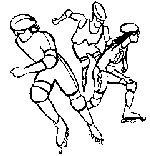

In-line skating is certainly much more than just a passing fad! Interest in the sport over the past few years has shown that it is here to stay! During the summers in Canada, it is hard to travel through a city on a nice day without seeing at least one in-line skater. In fact, even on rainy days you may see an adventurous skater or two!
There are many different types of in-line skating activities. A lot of people like to skate recreationally; it's a great way to get a little exercise, alone or in a social setting with friends. Families enjoy this sport, as it's something that can be done together, as everyone can go at his/her own pace. Some people use in-line skates to commute to work or to run errands. What a perfect way to stay in shape and to avoid the rush and hastle of public transportation or driving ... not to mention that it is more environmentally friendly and you avoid the parking lot fares! There are still others who blade as a serious fitness workout; it offers a great low-impact alternative to running.
The sport has expanded into a number of specialized areas. People have graduated from just recreational skating, into areas of personal choice. Some of these skating activities include roller hockey, speed skating, aggressive skating, slalom skating, artistic skating and dance skating. Some people even play in-line roller soccer!
Traditional roller hockey has been played for years by men and women on box skates (two wheels side-by-side). There has been a World Championship for men's roller hockey since 1936, and for women's roller hockey since 1992.
With the advent of in-line skates, in-line hockey for men and women has really started to take off! This is a different game than the traditional roller hockey played on box skates. A World Championship for men's in-line roller hockey started in 1995. There is yet to be a World Championship for women's in-line hockey, although it is well represented at such events as the North American Roller Hockey Championship (NARCh), USA Hockey In-Line Nationals, and Canadian Hockey In-Line Nationals. In-line roller hockey now boasts more than 15 leagues throughout the Greater Toronto Area, with an average of 200 players in each league. With so many vacant ice arenas in Canada during the summer, finding venues for the sport has not been a difficult task! We are also starting to see the emergence of specialized in-line hockey arenas with a plastic floor that operate year-round in Canada.
Others have taken up in-line speed skating. Like speed skating on the ice, a longer skate base is advantageous in this sport. In-line speed skating uses special in-line skates that have a longer chassis on which five wheels are mounted, instead of the typcial four weels. While speeds depend on the type of skating surface, the winner of a recent 42 kilometre race in Ottawa was able to average 30.5 kilometres per hour! Clearly, this sport is not for those who like to stand still!
Another offshoot of in-line skating is aggressive skating, where bladers, usually in their teens or early 20s, ride ramps and do tricks on rails. Aggressive skating can be done on the streets or at special ramp parks. A popular in-line skating prop for aggressive skating is the half-pipe, which can be made of concrete, plastic, or even wood. Another related in-line skating sport is slalom skating, in which skaters weave forwards or backwards through a row of pilons. If you think it looks easy, give it a try, and you'll be shown otherwise!
Finally, there are dance and artistic roller skating, which have been performed on box skates (2 wheels side-by-side) for a long time. Artistic Roller Skating includes artistic performances on skates, whereas dance roller skating incorporates a specific set of dance maneuvers. The majority of artistic skating still takes place on box skates, instead of on the newer in-line skates. There is a World Championship for dance roller skating.
